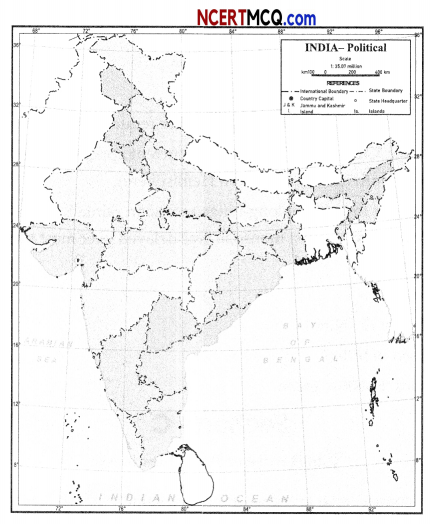Students can access the CBSE Sample Papers for Class 11 Geography with Solutions and marking scheme Term 2 Set 5 will help students in understanding the difficulty level of the exam.
CBSE Sample Papers for Class 11 Geography Term 2 Set 5 for Practice
Time : 2 Hours
Maximum Marks : 35
General Instructions:
- Question paper is divided into 5 sections A, B, C, D & E.
- In Section A question number 1 to 3 are Very Short Answer Type Questions. Attempt any 3 Questions.
- In Section B question number 4 is Source Based Question.
- In Section C question number 5 &6 are Short Answer Based Questions.
- In Section D question number 7 to 9 are Long Answer Based Questions.
- In Section E question number 10 is a Map Based Question.
Section – A
(Very Short Answer Type Questions) (2 x 3 = 6)
(Attempt All Questions)
Question 1.
What are the characteristics of ocean currents? [2]
OR
How do the sun’s rays while passing through the atmosphere gets absorbed? [2]
Question 2.
Why are tides important? [2]
![]()
Question 3.
What is the objective of Project Elephant? [2]
Section – B
Source Based Question (1 x 3 = 3)
Question 4.
EI – Nino and the Indian Monsoon:
EI – Nino is a complex weather system that appears once every three to seven years, bringing drought, floods and other weather extremes to different parts of the world. The system involves oceanic and atmospheric phenomena with the appearance of warm currents off the coast of Peru in the Eastern Pacific and affects weather in many places including India. EI – Nino is merely an extension of the warm equatorial current which gets replaced temporarily by cold Peruvian current or Humbolt current (locate these currents in your atlas). This current increases the temperature of water on the Peruvian coast by 10°C. This results in:
- The distortion of equatorial atmospheric circulation.
- Irregularities in the evaporation of seawater.
- Reduction in the number of planktons which further reduces the number of fish in the sea.
The word EI – Nino means ‘Child Christ’ because this current appears around Christmas in December. December is a summer month in Peru (Southern Hemisphere). EI – Nino is used in India for forecasting long-range monsoon rainfall. In 1990-91, there was a wild EI – Nino event and the onset of southwest monsoon was delayed over most parts of the country ranging from five to twelve days.
Attempt All Questions:
(i) What are the effects of El – Nino? [1]
(ii) How is EI – Nino used in India? [1]
![]()
(iii) What does the word ‘EI – Nino’ mean? [1]
Section – C
Short Answer Type Questions (2 x 3 = 6)
Question 5.
Differentiate between convectional rain and orographic rain? [3]
Question 6.
When was the comprehensive Wildlife Act enacted and what were are its objectives? [3]
OR
What do you know about saline soils? [3]
Section – D
Long Answer Type Questions (3 x 5 = 15)
Question 7.
Mention the causes responsible for soil erosion. [5]
Question 8.
Explain the factors that affect the insolation of the surface of the earth. [5]
OR
Draw a suitable diagram for the structure of the atmosphere and label it and describe it? [5]
![]()
Question 9.
Explain the different types of soil erosion. [5]
Section – E
Map Based Questions (1 x 5 = 5)
Question 10.
On the outline map of India indicate and mark the following features. (Attempt any 5)
(i) A place where Arid Soil is found in North India.
(ii) Largest Mangrove forest in India.
(iii) A South Indian state where Red Soil is found.
(iv) Biosphere reserves of Nanda Devi.
(v) The district where the first biosphere in India was developed.
(vi) The state where Pachmarhi Biosphere Reserve is situated.
